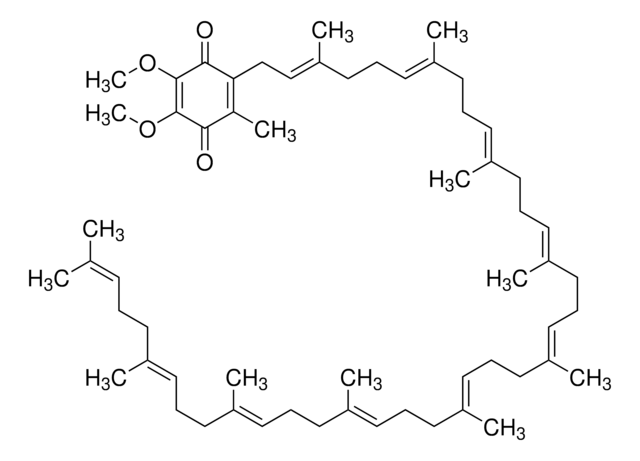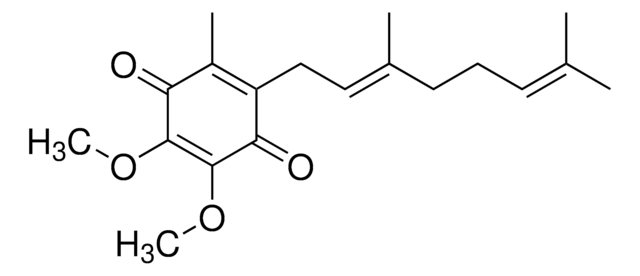C7956
Coenzyme Q1
≥95%
Synonim(y):
2,3-Dimethoxy-5-methyl-6-(3-methyl-2-butenyl)-1,4-benzoquinone, Ubiquinone-1, Ubiquinone-5
About This Item
Polecane produkty
Poziom jakości
Próba
≥95%
Postać
liquid
temp. przechowywania
−20°C
ciąg SMILES
COC1=C(OC)C(=O)C(C\C=C(\C)C)=C(C)C1=O
InChI
1S/C14H18O4/c1-8(2)6-7-10-9(3)11(15)13(17-4)14(18-5)12(10)16/h6H,7H2,1-5H3
Klucz InChI
SOECUQMRSRVZQQ-UHFFFAOYSA-N
Opis ogólny
Zastosowanie
Działania biochem./fizjol.
Inne uwagi
Kod klasy składowania
10 - Combustible liquids
Klasa zagrożenia wodnego (WGK)
WGK 3
Temperatura zapłonu (°F)
Not applicable
Temperatura zapłonu (°C)
Not applicable
Środki ochrony indywidualnej
Eyeshields, Gloves, multi-purpose combination respirator cartridge (US)
Certyfikaty analizy (CoA)
Poszukaj Certyfikaty analizy (CoA), wpisując numer partii/serii produktów. Numery serii i partii można znaleźć na etykiecie produktu po słowach „seria” lub „partia”.
Masz już ten produkt?
Dokumenty związane z niedawno zakupionymi produktami zostały zamieszczone w Bibliotece dokumentów.
Klienci oglądali również te produkty
Produkty
Learn about the four membrane-bound protein complexes that make up the electron transport chain metabolic pathway supplying energy as ATP for cellular respiration.
Nasz zespół naukowców ma doświadczenie we wszystkich obszarach badań, w tym w naukach przyrodniczych, materiałoznawstwie, syntezie chemicznej, chromatografii, analityce i wielu innych dziedzinach.
Skontaktuj się z zespołem ds. pomocy technicznej











